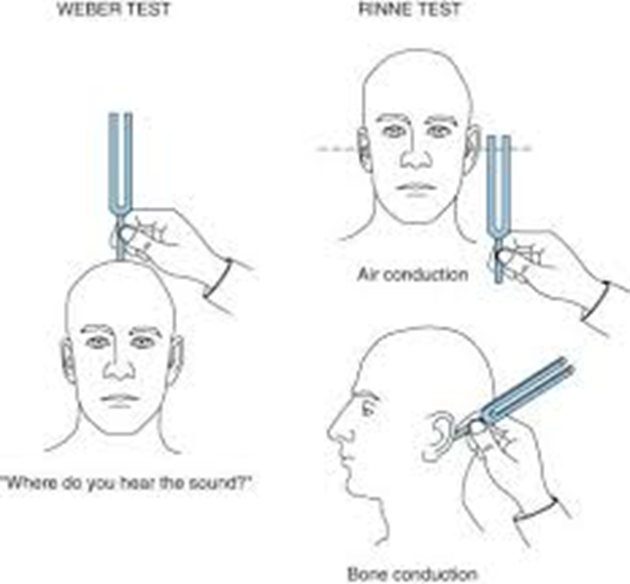A patient is diagnosed with left ear unilateral sensorineural hearing loss. During the performance of the Weber test, the nurse expects lateralization of the sound/vibration to the:

Left temporal bone
Both ears equally
Right ear
Left ear
The Correct Answer is C
Choice a reason:
The left temporal bone would be the expected site of lateralization for sound in a Weber test if the patient had conductive hearing loss in the left ear. However, with unilateral sensorineural hearing loss, the sound typically lateralizes to the opposite ear, which is the ear with better hearing.
Choice b reason:
Lateralization to both ears equally during the Weber test would suggest either normal hearing or symmetrical hearing loss. In the case of unilateral sensorineural hearing loss, the sound is not perceived as equal in both ears because the affected ear does not hear as well as the unaffected ear.
Choice c reason:
In a patient with unilateral sensorineural hearing loss in the left ear, the Weber test will lateralize to the right ear, which is the ear with normal hearing. This occurs because the inner ear on the affected side is not able to transmit the sound as effectively as the unaffected side, making the sound seem louder in the ear with better hearing.
Choice d reason:
Lateralization to the left ear in the Weber test would indicate conductive hearing loss in the left ear, not sensorineural hearing loss. In sensorineural hearing loss, the sound vibrates to the ear with better cochlear function, which would be the right ear in this case.
Nursing Test Bank
Naxlex Comprehensive Predictor Exams
Related Questions
Correct Answer is C
Explanation
Choice A reason:
Tachycardia, or an abnormally rapid heart rate, is not a typical finding in myxedema. Myxedema is associated with hypothyroidism, which usually presents with bradycardia, or a slower than normal heart rate, due to the decreased metabolic demands on the body.
Choice B reason:
Diarrhea is not commonly associated with myxedema. Instead, patients with hypothyroidism and myxedema often experience constipation due to slowed gastrointestinal motility.
Choice C reason:
Facial edema, particularly around the eyes, is a classic sign of myxedema. Myxedema is a severe form of hypothyroidism that can cause mucopolysaccharide deposition in the skin, leading to non-pitting edema. This can be particularly noticeable in the face and periorbital area.
Choice D reason:
Heat intolerance is more commonly associated with hyperthyroidism, not hypothyroidism. Patients with myxedema typically have cold intolerance due to a decrease in basal metabolic rate and reduced heat production.
Correct Answer is B
Explanation
Choice A Reason:
Tracheal sounds are harsh, high-pitched breath sounds typically heard over the trachea in the neck. They are not expected to be heard over the peripheral lung fields of a young adult during a routine lung auscultation.
Choice B Reason:
Vesicular breath sounds are the normal sounds heard over most of the lung fields. They are characterized by a soft, low-pitched, rustling sound during inhalation and are softer during exhalation. These sounds are created by air moving through the smaller airways such as the bronchioles and alveoli.
Choice C Reason:
Bronchovesicular sounds are heard over the major bronchi and are characterized by a moderate pitch and intensity. They are typically heard between the first and second intercostal spaces at the sternal border anteriorly and between the scapulae posteriorly, not over most of the lung fields.
Choice D Reason:
Bronchial breath sounds are high-pitched and louder than vesicular sounds, with a hollow quality, and are normally heard over the manubrium. If heard over the peripheral lung fields, they may indicate lung consolidation or other abnormalities.
Whether you are a student looking to ace your exams or a practicing nurse seeking to enhance your expertise , our nursing education contents will empower you with the confidence and competence to make a difference in the lives of patients and become a respected leader in the healthcare field.
Visit Naxlex, invest in your future and unlock endless possibilities with our unparalleled nursing education contents today
Report Wrong Answer on the Current Question
Do you disagree with the answer? If yes, what is your expected answer? Explain.
Kindly be descriptive with the issue you are facing.
